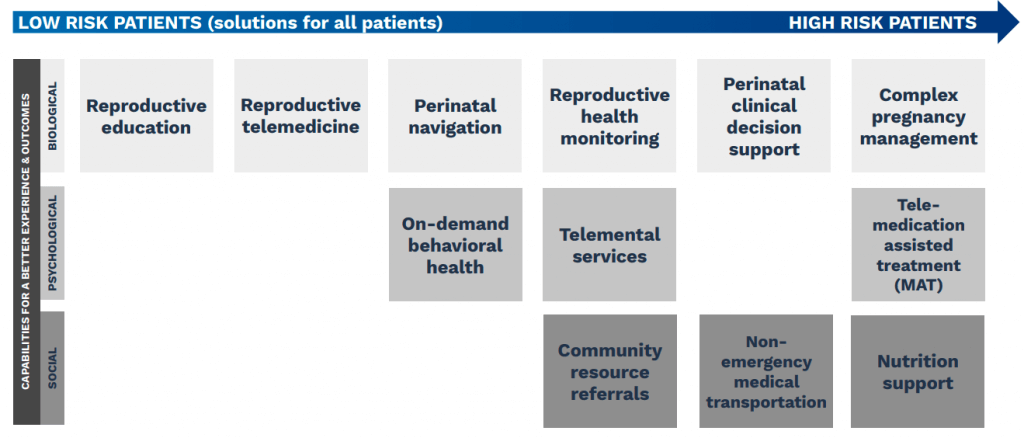
Public Health is on Life Support
Sarah Carroll, Director, Center for Care Transformation, AVIA
Insights
Sarah Carroll, Director, Center for Care Transformation, AVIA

Pregnancies are make-or-break opportunities to initiate a relationship between women and your health system and build long-lasting brand loyalty. According to NRC Health, the number one driver of women’s loyalty to a healthcare brand is their previous experience, and that loyalty is worth an estimated $1.4 million over each patient’s lifetime.
Delivering high-quality perinatal care to all is also a health equity imperative. Nearly 23% of expectant mothers go without prenatal care until their second and third trimester. The CDC has estimated that 3 out of 5 maternal deaths are preventable, disproportionately affecting Black and American Indian/Alaska Native women.
There is a strong case for providing exceptional perinatal care to advance health equity and nurture mothers and their children into becoming lifelong customers. In order to compete in an increasingly modernized landscape, health systems must find ways to connect with patients in innovative ways using digital.
Health systems generally rely on human-centered, evidence-based care models when considering their next innovation. Digital solutions offer the benefits of scale, sustainability, and safety for organizations.
Focusing on digital transformation can help your health system provide convenient access and a seamless personalized perinatal care experience to mothers and neonates. It can also allow you to deliver increased value to payers by digitally orchestrating specialty care. By embracing digital as a platform for care delivery, your organization will evolve from “doing digital” to “being digital.”
When looking for ways to bring digital to the forefront of your perinatal care strategy, first analyze your organization’s services, risks, and overall goals.
If you are laser-focused on labor and delivery services with limited prenatal and postpartum care, your primary concern should be safety. Look for solutions that reduce maternal and neonatal morbidity and mortality and limit malpractice premiums and claims.
Organizations that operate under a fee-for-service model with a full suite of OB-GYN services should focus on capacity. Digital solutions can help you serve more people with greater efficiency and deliver on HEDIS quality expectations.
Organizations with a greater mix of value-based contracts or Medicaid patients should use digital to optimize utilization, reducing ED visits, unnecessary hospitalizations, NICU admissions, and length of stay.
Finally, if your organization strives to be the perinatal care leader in your region, your digital strategy should address all factors named above. The goal is to improve population health outcomes for mothers and babies in your region, including reducing the preterm birth rate, elective deliveries under 39 weeks, and cesarean rates.
Digital offers opportunities to more efficiently address your patients’ biological, psychological, and social needs. Your organization should be aligned to a whole-person care strategy and population health goals, based on the unique needs of your patient population.
The framework below highlights the 12 digital capabilities of a comprehensive whole-person strategy that considers a range of biopsychosocial needs. The two capabilities in the upper left corner, reproductive education and telemedicine, move traditional perinatal services from office-based to virtual support for all women, from low- to high-risk.
For women with rising risk, additional services, such as in-home remote monitoring and on-demand behavioral health, will deliver a more customized experience and higher quality care. Providers serving women with the most significant clinical, behavioral, and social needs will benefit from solutions such as tele-medication assisted treatment (MAT) and nutrition support to manage the risk of avoidable emergencies and complications.

Organizations that strive to become a truly digital, 21st-century health system should incorporate a range of solutions into their strategy, in order to address the needs of all patients.
Creating a digital strategy that can be approved and implemented at your organization requires a solid business case. COVID-19 has clearly increased the need to provide virtual care, target at-risk mothers-to-be, and coordinate care with community services, but is the financial value there?
According to the business tools available on AVIA Connect, the value gained from incorporating digital into perinatal care is clear. Solutions like clinical decision support, digital navigation, community resource referrals, and remote monitoring can increase safety, capacity, utilization, and outcomes. Analysis found each of these solutions individually can lead to a $2 million to $13.2 million revenue gained or cost savings achieved for every 100,000 patients served.
If you are ready to incorporate digital into your perinatal care strategy, AVIA is here to partner with you. The experts at our Center for Care Transformation can help you assess your current state, design a digital perinatal care strategy, compare solution companies, and build a business case so you can offer the best possible care to your perinatal patients. Contact us today to learn more!